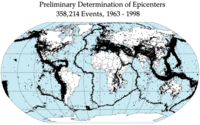
Photo from wikipedia
The failure mechanism and limit support pressure are essential factors for the stability assessment of tunnel face during shield tunneling. Previous studies were mostly based on the assumption that soil… Click to show full abstract
The failure mechanism and limit support pressure are essential factors for the stability assessment of tunnel face during shield tunneling. Previous studies were mostly based on the assumption that soil fails when the plastic limit is reached. The static liquefaction of saturated sand at pre-failure state often largely reduces shear strength; a stable tunnel face could be destabilized and even collapses abruptly. This paper aims to explore the static liquefaction failure of tunnel face in saturated sands by 3D discrete element simulation. The particle shape is considered by using clump composed of two identical spheres, and the micro-material parameters are calibrated by fitting against triaxial tests. The tunnel face is initially supported by the earth pressure at rest, and then the pressure is reduced by applying a displacement on the free surface until soil body completely collapses. The second-order work during the unloading process is calculated, and a negative value denotes the initiation of static liquefaction. The distribution of negative second-order work point shows the initiation and propagation of static liquefaction. The ultimate failure mode is shown to be composed of a sliding wedge and an overlying chimney, and the chimney is confined to a local area for soil arching. The experienced stress path of tunnel face verifies the existence of static liquefaction instability, indicating the stability analysis should consider static liquefaction rather than simply using the conventional plastic limit state analysis.
Journal Title: Acta Geotechnica
Year Published: 2019
Link to full text (if available)
Share on Social Media: Sign Up to like & get
recommendations!